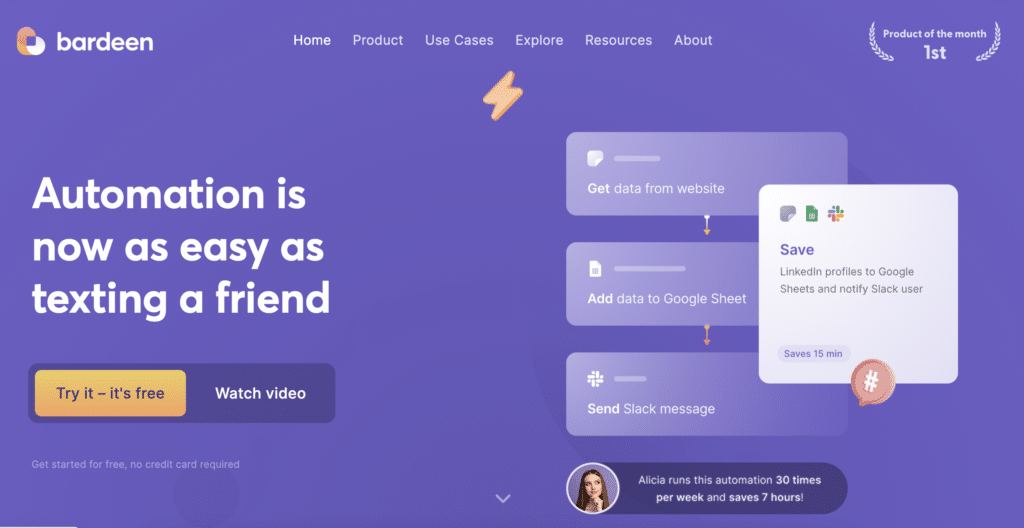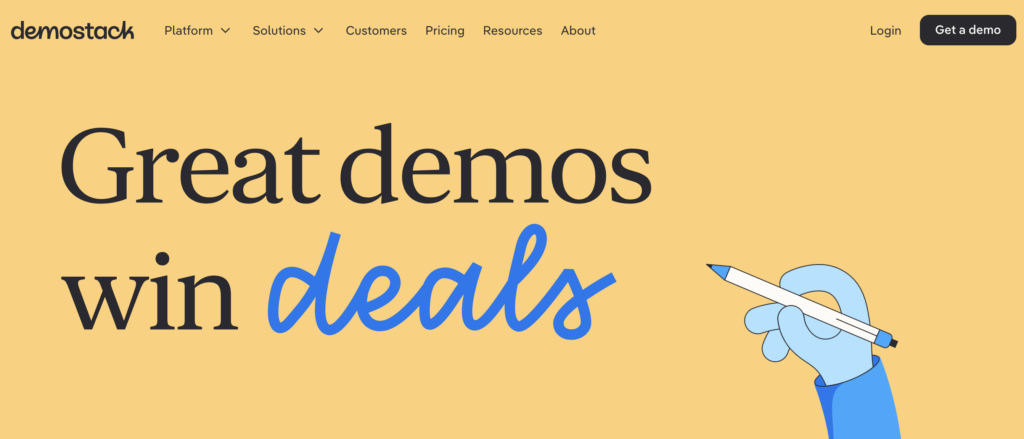Enterprise software and services sales are equal part art and part science. To merge the two, you need one of my favorite methods: question based selling (QBS).
With QBS, the idea is to ask intelligent questions to aid you in winning deals. This is an effective way to get prospects to think deeply about their needs and wants while also allowing salespeople (you!) to build rapport with key decision influencers and makers.
Let’s explore how to leverage question based selling to close B2B SaaS deals.
What is question based selling?
Question based selling is a sales technique that involves asking open and close ended questions to help prospects uncover their preferences and requirements. The goal is to engage potential customers in a conversation that allows you to understand their business and tailor the sales pitch accordingly vs hard pushing features and incentives. By asking questions, salespeople can uncover key information about the customer’s business, their goals, pain points and the triggering event that got you through the door.
Question lead sales, however, is not a one-size-fits-all approach. It requires industry knowledge, experience, research and preparation.
Secrets of question based selling
At its essence, question based selling involves indirect probing to uncover the deepest motivations of the prospect. Then you can align your entire sales approach — and how your product/service will be of value — around what you’ve learned about the customer.
1. Do your research and prepare
One of the keys to success with QBS is research, preparation and the tailoring of your narrative. Let’s cover a couple of my favorite intel-gathering approaches.
Find leads who are already spending money
This approach means targeting customers already using similar software products (your direct competitors or indirect competitors in the case of a fragmented tech stack). They are more likely to be interested in your product and will be more receptive to a sales pitch that highlights the benefits of what you have to offer.
To find those leads, use any sales tool such as Lusha, LeadFeeder or even BuiltWith to get the current “technographic” information of a company.
Hint: Accentuate and sympathize with your customer’s frustrations with the rival technology they are using. Highlight how better their day-to-day will be with your solution in place.
Find leads with stepping-stone technology
This approach involves targeting customers who are using similar but less advanced technology. They are more likely to be interested in your product if they understand how it improves their current technology ecosystem and work life.
Hint: The typical scenario is that you are selling to growing companies that are ready to make the jump to a more mature tech stack (your solution) to improve their operational efficiency as they’ve hit the technical limits of the junior suite.
2. Know your prospect’s motivations and the KPIs they are held to
To consistently win large B2B SaaS deals, you need to understand your persona’s motivations and KPIs. This knowledge will help you form the basis of a trustful relationship with them. Start by building an ideal customer profile (ICP) that outlines the characteristics of your target customer.
→ Download now: ICP worksheet for B2B teams
Next, build a target persona that details the specific characteristics of the person you are selling to.
Top motivators:
- Frustration with existing system’s limitations
- Dissatisfaction with customer service
- Need to save time in day-to-day work
- Automation of manual processes
3. Show genuine interest and depth of knowledge via a needs analysis approach
Forget about selling. That’s not what your first sales meeting is about. Instead, focus on connecting with your prospective buyer by understanding their needs. That’s where the question based approach shines.
You can ask a few questions to open up a world of customer use cases to which you can tailor your presentation. Showing genuine interest via questioning will build a trust based relationship and help you lock in the next meeting, in which you’ll get closer to closing the deal. Here’s what you should do:
Understand the pain points
You’ve scored the first sales/demo meeting with a prospect because they’ve come to a realization that something has to change to make their workflow better. You’re in the driver’s seat to elicit what got them to this point and what they think they need to solve the problem/s. Open up with a simple “how may I help you?” or “do you have examples of what you need help with?” and actively listen to what the prospects and customers say.
Write down their pains in a use-case format
By aligning pain points against roles and expected outcomes, you’ll easily be able to qualify if your solution is a good fit for the customer as well. By knowing the use cases you’re looking to solve, you can hyper-tailor your next platform/solution demo meeting to show how you’re the solution over the competitors.
4. Understand who is involved in the decision-making process
In B2B SaaS companies, multiple stakeholders are involved in the purchasing decision. A typical B2B buying panel has six to 10 decision makers, according to Gartner. Mapping out and involving key stakeholders is essential to closing a SaaS deal successfully.
As the salesperson, you need to understand the roles of each sales decision maker and their influence in what often is a group purchasing decision. From my experience, here are the top types of stakeholders in a sales process (some of which can be the same person):
- The researcher/user: Typically a junior role who has some experience in the industry and their specific function and was given the task of shortlisting best-fit solutions. You’ll encounter this role more frequently in larger corporations rather than in startups.
- The embattled user/technical buyer: The person you really need to impress as they are frustrated with their current workflow. All of your emotional intelligence needs to be focused on befriending this person. Question based selling is the perfect way not only to show them your knowledge of the industry but also to connect with them on a personal level. They must see that you are their solution to them going home at 5pm.
- The budget holder: Typically the COO or the CFO, who is typically absolutely disconnected from the context of your solution. They need to see that your pricing and time to implement is on par with market averages — or they’ll blindly trigger a further research cycle to find another solution (often inferior) that looks cheap on paper. Keep in mind that, after all, it’s their job to keep operations cost-effective.
- The cautious CTO: They’re worried about a fragmenting tech stack and not dedicating any of their often thin-stretched resources to supporting a new integration. In growing startups, this role is also responsible for cybersecurity, as they are the acting CISO.
- The paranoid CISO: Similar to the CTO, they are worried about attack surface and a fragmented tech stack. You’ll encounter this role more often in much larger companies and, as long as you’ve got your security certification (e.g., SOC2), you’re kosher.
- The overwhelmed ownership/executive sponsor: Bring them additional easy-to-access and visibility, show them how your solution influences employee experience and departmental productivity and you’ll make the “good people” list. If your solution doesn’t offer unified reporting, easy implementation and causes more complaints, then you’ll be on the “non-friendly” list.
- Procurement and legal: Aka, the most hated department by salespeople. Their job is to ensure you come in at a reasonable cost according to market averages and to ensure fair contract terms. You’ll encounter this role more frequently in massive publicly traded companies. Just navigate them by understanding all the bureaucratic paperwork and stages they need you to jump through upfront so that the deal doesn’t tank due to missing docs/timelines/certifications etc.
To help you navigate the stakeholders in your sales process, create a sales decision making map outlining the key decision makers, their roles and their relationships within the company.
This map can help you tailor your messaging and strategy to each decision maker’s unique needs and concerns.
Sales decision maker map example (table below)
The scenario: Let’s say you are selling a mobile device management (MDM) solution to a growing SaaS consultancy startup. This is a real scenario based on our experience. Shoutout to www.kandji.io and www.apple.com/ca/business/ for the killer customer-enabling sales process.
| Role | Current workflows | KPI | Pain point to solve | How can they block the deal | Role in process | Salesperson next step |
|---|---|---|---|---|---|---|
| Head of Development/CTO/CISO | 1. Manually updates machines and is frustrated with the time wasted 2. Uses Excel sheet to track software subscriptions and usage 3. Manually pushes security updates with third-party providers | 1. Keep attack surface minimal 2. Ensure employees have the most recent version of apps or new software | 1. Manually updating machines 2. Not having oversight into security scanning 3. Employee onboarding with correct OOB software | 1. If you don't offer a free trial that is self-serve 2. If you cannot sync with existing email provider accounts 3. If the rollout isn't fast 4. If it isn’t compatible with existing tech stack | 1. End-user/researcher 2. Software solution shortlister 3. If solution is purchased, they will be the ones to implement | 1. Show integration capability 2. Spotlight your documentation center and self-serve capability |
| COO/CFO | 1. Manually follows up with CTO on the state of software usage and license expiration dates | 1. Reduce technology debt 2. Onboard new employees in under one week | 1. Onboarding of new employees is slow and takes up to two weeks 2. Needs holistic view of all software used by devices | 1. If the solution is too expensive (even if features are good) | 1. Decision-maker and budget holder | 1. Provide multiple payment options and plans to fit a tight budget |
| Company owner/Co-founders | 1. Firefights when people and clients complain, talks to CTO and COO to resolve problem | 1. Keep the team happy 2. Keep team productive 3. Keep company secure 4. Keep clients happy via the upkeep of a modern tech stack | 1. Employee experience is low, leading to stress and potential turnover 2. No visibility into apps people said they want and will use vs the ones they actually use | 1. If the buying process is painful 2. If the solution is too expensive 3. Too many salespeople to talk with | 1. Decision influencer | 1. Highlight a customer case study similar to theirs |
Involving all decision makers in the sales process helps prevent surprises later in the sales cycle, increasing the likelihood of a successful outcome.
👉 Read this Gartner article on SaaS buying experience to learn more about stakeholders involved in the software buying journey.
5. Know the timeline of the project
The customer’s project timeline can help the salesperson understand the deal’s urgency and map out project stakeholders (in case you’ve missed it on the decision making map). It also helps the company to staff the project appropriately.
- If the customer needs the project completed within a short period, it shows that the deal is urgent and senior management from the customer’s end may be involved. In this case, the salesperson should work to close the deal as soon as possible.
- If the customer has a flexible timeline, I suggest really digging into their use cases and involving the right technical subject matter experts (SMEs) from your side as well to display industry knowledge and willingness to add immense value.
Understanding the customer’s timeline also helps you forecast the staffing and the true cost of the project appropriately. For example, if the project is time sensitive, the company may need to assign additional resources to the project to ensure timely completion.
6. Know how to ask both open and closed questions
Open and closed ended questions are useful for uncovering critical deal drivers, breakers, urgency, feature and staffing needs.
- Open ended questions encourage customers to talk about their needs in detail.
- Closed ended questions are useful for verifying specific information to help you qualify the deal faster.
Question based selling: Examples of what to ask
See the examples below divided into open ended and close ended questions:
Open ended question examples
Open ended sales questions are perfect for building rapport with the prospect.
- What are your biggest challenges right now?
- How do you currently handle [specific business process]?
- How do you see our solution fitting into your overall strategy?
- What are your goals for the next [specific time period]?
- What other solutions have you considered so far?
- Have you tried solving these challenges before? What happened?
- How do you measure success in [specific area]?
- What are the most important features you are looking for?
- How would you rate your current solution?
- What are the biggest pain points for your team?
- If you don’t resolve the current problems, how will it affect your business in the next two quarters?
- Can you walk me through your decision-making process?
Close ended question examples
Close ended questions are laughed at/frowned upon by salespeople — except the joke is on the person who doesn’t use these powerful tools at the right moment in the sales meeting. Closed questions, when used correctly, allow you to get critical information to help qualify a deal, timeline, budget, decision-making status, technology stack and so on. Just don’t start the meeting with them as you can pigeonhole yourself fast.
- Is your budget for this project within $X and $X?
- Are you just starting research on this, or is the budget already put aside for this initiative?
- Have you used our solution before?
- Are you the final decision maker on this project?
- Is there a specific timeline you need to meet?
- Are there any hard deadlines we need to be aware of?
- Do you prefer on-premise or cloud solutions?
- Which solution/s are you looking to potentially replace with our solution?
- Is there a specific feature that is a must-have for your team?
- Do you have a preferred implementation timeline?
- Have you had any issues with your current solution?
- When do you want to schedule a follow-up working session?
7. Make your customer feel heard
The whole point of the question based sales framework is to get your customer to feel heard. Although questions help you get there, throughout your questioning you also need to follow the below time-tested rules of a healthy two-way conversation exchange.
So, how can you make your potential customers feel heard and understood?
- Listen actively: When a customer speaks, listen actively by giving your full attention and avoiding distractions. Respond with empathy and take notes to demonstrate that you are interested in what they have to say.
- Repeat and clarify: After the customer has spoken, repeat their concerns back to them to ensure that you have understood correctly. Clarify any unclear points and ask one or two follow-up questions to gain a deeper understanding.
- Acknowledge emotions: Acknowledge the customer’s emotions and validate their feelings. For example, if a customer is frustrated, you might say, “I understand how frustrating that must be for you.”
- Personalize the experience: Tailor your approach to each customer based on their unique needs and preferences. This approach shows that you value them as an individual and that you are invested in their success. Avoid the common SaaS sales mistake of powering through a bland one-size-fits-all demo — that’s how you lose a sale.
- Follow up: After the conversation, follow up with the customer with detailed notes to ensure that their concerns have been addressed and that they are satisfied with the outcome. Yes, you can also leave follow-up questions within your notes as an indication of interest from your end.
When customers feel like they are genuinely listened to and understood, this perception can have a significant impact on their experience, loyalty and willingness to do business with you.
☝️ In B2B, perception can make or break your deal. Read our brand perception guide to understand why.
8. Line up a problem-solving session (the next sales meeting)
The whole point of your first sales meeting is to score the second meeting (literally). The second session is all about diving deep into user scenarios (problems you are looking to solve).
Here’s how to ensure you run a successful second meeting, which brings you to a close/almost close.
- Tell the prospect to bring people involved.
- Bring their counterparts from your end.
- Show the scenarios in a table mapped to features.
- Clarify the risks of the project.
- Discuss the SWAG timeline of the project.
Benefits of question based selling
We’ve covered a lot of topics above, and you’re amazing for staying focused with me here, so, to ensure we didn’t lose sight of the most important benefits (and to bring this all together), here’s what I’ve mapped the top benefits of QBS to be:
- Better understanding of customer needs: By asking the right questions, salespeople can uncover the specific needs and pain points of the customer. This understanding enables you to tailor the pitch for resonance, leading to a more personalized and effective sales process.
- Increased customer engagement: Asking questions shows interest in what the prospect has to say. This approach encourages customers to engage in the conversation and share information that can be used to develop a tailored solution (or a seemingly tailored one).
- Improved credibility and trust — key to increased conversions and decreased churn: By demonstrating that you understand the customer’s challenges, you can establish credibility and build trust. This approach can lead to stronger customer relationships and increased sales via referrals and easier upsells.
- Enhanced communication skills: The QBS approach involves asking open ended questions that encourage dialogue and discussion. By practicing this approach, your sales team can improve their communication skills and develop a deeper understanding of your solution’s value points and how to engage in a powerful value-driven conversation with the prospect.
Disadvantages of question based sales framework
If you’re too focused on asking questions and not enough on building rapport with the prospect, it can be difficult to establish a strong relationship that leads to a SaaS sale.
The discovery process can be time-consuming, and it may not always be clear when to transition from discovery to a demo. According to sales stats by Gong.io, sales reps who spend too much time on discovery calls have a lower chance of closing the deal. The faster you get your critical questions answered to be enabled for an intelligent customer-centric demo, the better your chances are at closing the deal.
It’s also important to note that not all prospects are the same. In some scenarios, the prospect may already have a good understanding of their needs and be ready for a demo. In other cases, the prospect may be more guarded and must be led through a series of questions to uncover their needs.
Sales software that enables QBS with intelligence
- Lusha: This sales intelligence tool provides access to a large database of B2B contacts and enables sales reps to quickly find the contact information they need to reach out to decision makers. Salespeople can leverage its Chrome extension to access contact information on LinkedIn or other platforms, import contacts into a CRM and enrich their prospecting data.
- Bardeen: This virtual sales assistant helps marketing and sales teams to automate their lead generation and outreach efforts. It uses AI to send emails and follow-ups to prospects and automate the scheduling of sales meetings, among other features.

- Lucidchart: This visual collaboration tool helps salespeople to create and share diagrams, flowcharts and other visual content with their prospects. Lucidchart can be used to enhance the effectiveness of sales demos, presentations and proposals.
- Demostack: This sales enablement platform helps sales teams to share interactive product demos with their prospects. Sales reps can quickly create custom product demos that showcase the features and benefits of their products in a visually compelling way.

- PandaDoc: This document automation tool helps teams to create, send and track their sales proposals and contracts. Sales reps can leverage templates and reusable content blocks that can be easily customized for each prospect.
- HubSpot: This all-in-one sales and marketing software helps teams to manage their sales pipeline, automate their outreach efforts and track their sales activity. Sales reps can use HubSpot’s CRM to store all their customer data in one place and gain visibility into their sales efforts.
How Productive Shop helps startup sales teams get more leads
Buyers are looking for a salesless journey, so it’s critical to have your website — from design to organic search execution and lead attribution — actively helping you bring in the right type of leads. You need a partner who knows what works for technology startups and can offer this holistic approach to marketing and sales. Here’s where Productive Shop comes in.
We have a proven process to enable demand generation, powered by intelligent search insight.
Schedule a call to learn about our B2B growth services.
Frequently asked questions
Why are questions so effective in sales?
Questions are so effective in sales because they allow salespeople to gather information about the prospect’s needs, pain points and preferences. By asking questions, salespeople can tailor their message to the prospect’s specific situation, making the conversation more engaging and relevant.
Questions can also be used to build rapport with the prospect and establish a relationship of trust. By asking questions, salespeople can uncover objections or concerns that the prospect may have, allowing them to address these issues and move the sales process forward.
What are the four types of selling questions?
The four types of selling questions are open-ended questions, closed-ended questions, probing questions and leading questions.
- Open-ended questions allow the prospect to provide a more detailed response and can be useful in uncovering needs or pain points.
- Example: What are your top priorities for [specific business process or function]?
- Closed-ended questions are useful for obtaining specific information and can be answered with a simple “yes” or “no.”
- Example: Would you prefer an annual subscription plan for our software?
- Probing questions are designed to elicit more information and to clarify the prospect’s needs or preferences.
- Example: Can you tell me more about your decision-making process when evaluating new software solutions?
- Leading questions are designed to influence the prospect’s response and can be used to steer the conversation in a particular direction.
- Example: How are you currently managing your [specific business process] and what challenges have you faced with your current solution?
What is value based selling?
Value based selling is an approach to sales that focuses on the value that the product or service can provide to the customer. Rather than focusing solely on the features and benefits of the product, value based selling seeks to understand the customer’s needs and preferences and to position the product as a solution to those needs.
This approach requires a deep understanding of the customer’s business and their specific challenges, as well as the ability to articulate how the product can address those pain points.
Is value based selling the same as question based selling?
Value based selling and question based selling share some similarities, but they are not the same approach.
- Value based selling is focused on understanding the customer’s needs and positioning the product as a solution to those needs.
- Question based selling is focused on asking questions to uncover the customer’s needs and pain points.
Both approaches are often used in combination to build a deeper understanding of the customer’s business and position the product in a way that provides maximum-perceived value.
Needs based selling vs question based selling: what is the difference?
Needs based selling and question based selling are two distinct sales methodologies:
- Needs based selling focuses on identifying customer needs through observation and inquiry. For example, a needs based seller might observe that a customer is interested in a particular product and offer additional information or upsell opportunities based on that observation.
- Question based selling involves asking strategic questions to uncover the customer’s unique needs and pain points. A question based seller might start the conversation by asking the customer about their specific needs and preferences, then use that information to tailor the pitch and offer a personalized solution.
Needs based selling can be useful for identifying opportunities to cross-sell or upsell products, while question based selling can help build rapport, establish trust and develop a deeper understanding of the customer’s unique needs.
How do I handle the most common objections in SaaS sales?
The most common objections in SaaS sales include concerns about price, competition and implementation. To handle these objections, it is important to listen to the prospect’s concerns and to address them directly.
- If the prospect is concerned about price, the salesperson can explain the value that the product provides and how it can help the prospect achieve their goals.
- If the prospect is concerned about competition, the salesperson can provide information about the product’s unique features and how it compares to the competition.
- If the prospect is concerned about implementation, the salesperson can provide information about the implementation process and offer support and resources to ensure a smooth transition.
How can I leverage AI for sales intelligence?
Here are a few ways AI can help with sales enablement by:
- Analyzing data about a prospect’s behavior, interests and demographics to help the sales team craft personalized outreach messages that are more likely to resonate.
- Identifying trends and patterns that can inform their prospecting and outreach strategies.
- Automating follow-up tasks like sending emails or scheduling meetings, freeing sales reps’ time to focus on more high-value activities.
- Helping salespeople prioritize leads based on their likelihood to convert, so they can focus their efforts on the most promising prospects.






